
Navigating a Safe Return to Work: Best Practices for U.S. Office Building Owners and Tenants
Release Date: June 2020
Measures to contain the coronavirus outbreak temporarily slowed economic activity and dramatically reduced occupancies at many commercial buildings. As state and local governments outline plans for a phased reopening of the economy, office building owners and employers are formulating plans that will allow employees to return safely to work.
This research brief provides an overview of best practices in improving safety against the coronavirus for building owners and employers. It focuses on immediate measures to improve building safety. A future research brief will address longer-term implications of the coronavirus outbreak for building operations. The brief draws from guidance provided by the U.S. Centers for Disease Control and Prevention (CDC), Cushman & Wakefield and JLL; insights provided by Gensler staff in a recent NAIOP webinar; and recent media reports.1 Readers should consider referring to individual guides and to the CDC website for additional recommendations.
Best Practices for Building Owners
Reopening Buildings
Owners of buildings that have been partially or entirely vacated during the outbreak need to complete several tasks to ensure that buildings are clean, safe and in good working order before reopening.
Equipping and Training Staff
As an initial step, building owners need to acquire personal protective equipment (PPE), such as gloves, masks and hand sanitizer, for cleaning, maintenance and operations staff, as well as disinfectant and cleaning supplies in quantities that are sufficient to meet ongoing operations. All staff require training in the proper usage and disposal of PPE, the proper application of disinfectants, proper handwashing techniques and social-distancing measures that are in accordance with CDC and Occupational Safety and Health Administration (OSHA) guidelines. This training is critical to ensure the health and safety of staff and building occupants.

Cleaning and Disinfecting
Before beginning a thorough cleaning, provide staff with training on protocols for both general cleaning and enhanced cleaning for areas that are heavily used, such as gyms, locker rooms, conference rooms and restrooms. This training should address how to clean surfaces with government-approved disinfectants, chemical dwell times needed for proper disinfection, and the safe disposal of regular office waste and PPE. Detailed CDC guidance on best practices for cleaning and disinfecting buildings and workspaces is available here.
Inspection and Maintenance
Maintenance staff need to thoroughly inspect buildings for any damage that might have occurred during vacancy and to ensure that all building systems are in good working order. These include fire life systems, mechanical systems, water systems, conveyances, drains and pipes. The CDC advises that prolonged periods of reduced building operations can make buildings susceptible to mold and Legionella bacteria. Detailed CDC guidance on mold inspection and mitigation, as well as water systems inspection and management protocols to combat Legionella bacteria, is available here. Before reopening a building, it is best to start systems methodically and allow them to operate long enough to ensure they are functioning properly.
HVAC Systems
HVAC systems are of particular importance due to their role in circulating and purifying the air. Prior to reopening, conduct an air flush of the building to reduce pollutants and particulate matter in interior space. Staff should then replace the filter, preferably with one that meets the highest recommended efficiency rating for the building. To ensure safety, staff must avoid shaking the old filter and should dispose of it in a plastic bag. Next, increase the HVAC system’s fresh air intake and ensure that the HVAC system is configured to maintain positive building air pressure. Ideally, HVAC systems should run entirely on fresh air, rather than relying on recirculation. If a building’s HVAC system has not been active for a prolonged period, the CDC advises that the system run for 48-72 hours before occupants return to mitigate any potential exposure to mold.2 As a longer-term measure, consider retrofitting HVAC systems to improve humidity control, as well as adding supplemental filtration and ultraviolet germicidal light installations in airhandling units.
Adapting Office Building Operations
Owners should adjust office building operations and interiors to improve safety while the coronavirus outbreak remains a significant public health concern. Many of the recommended tasks identified here can be implemented before reopening a vacant building, but they can also be readily implemented within buildings that have remained in operation during the outbreak. Clear and regular communication with tenants is important for implementing any of the following measures.
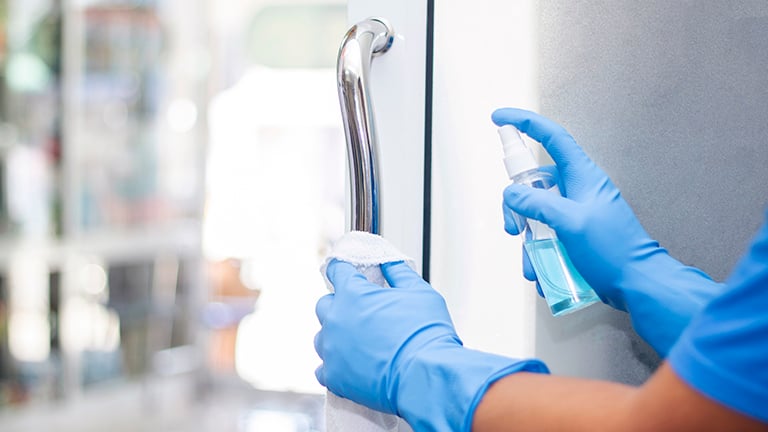
Enhanced Cleaning Protocols
Adopting advanced cleaning and sanitation protocols is one of the most immediate and important steps that building owners must adopt to improve occupant health and safety. All cleaning staff should receive and be trained in the use of PPE and in cleaning protocols that are consistent with CDC and OSHA guidelines. If tenants contract their own janitorial services, coordinate with vendors to ensure that all janitorial staff adhere to the same cleaning and PPE protocols. Do not permit building staff or vendors with symptoms of coronavirus to enter the building.3 If coordination between multiple janitorial vendors proves difficult, consider working with tenants to centralize janitorial services.
Workspaces and common areas will require regular cleaning and disinfection at more frequent intervals than was common before the outbreak. Owners can coordinate office cleaning times and intervals with tenants to meet their needs and expectations. While daily cleanings may be appropriate for some tenants, others may require multiple cleanings per day for workers who arrive in different shifts. Some tenants may also prefer cleanings during business hours so employees can confirm that the office is being cleaned regularly. In these cases, additional coordination will be needed to ensure that building staff can clean occupied offices while maintaining safe social-distancing protocols. Heavily used common areas and spaces within tenant offices, such as restrooms, elevators and break rooms, will require multiple cleanings per day, with particular attention paid to high-touch surfaces.
Building owners should also communicate safe hygiene and cleaning practices to tenants. For example, it is important that tenants encourage employees to wash their hands regularly and maintain an uncluttered desk to facilitate regular disinfection. Owners and tenants can collaborate on cleaning protocols for specific areas, such as private offices or individual desks, and confirm who will be responsible for cleaning these areas. Regular cleanings are particularly important for any shared areas or shared desks within tenant offices.
Facilitating Social Distancing and Hygiene
Building owners can take several actions to facilitate social distancing and improve occupant safety. Staff can post signs at key locations to remind occupants of social distancing and safe hygiene practices. These can take several forms, such as placards within restrooms reminding users to wash their hands for at least 20 seconds, or floor signs indicating safe spacing in reception areas, in elevator lobbies or within elevators themselves. Use temporary signs as a reminder of lower roomoccupancy limits that are consistent with the six-foot socialdistancing rule and with state and local regulations on maximum gathering sizes. Owners should consider adding real-time meters at office entrances that display how many people are present. Use signs to identify the safest routes for foot traffic within buildings. Where possible, owners should collaborate with tenants to identify and demarcate one-way traffic flows that allow occupants to circulate within the building without passing each other in narrow corridors. Signs can also remind users to leave office, restroom and common-area doors propped open and to leave light switches in the “on” position during business hours. In some instances, owners and tenants may wish to remove door handles or remove some interior doors altogether. These measures will reduce the frequency with which occupants need to interact with high-touch surfaces.
It will be important for owners to either close shared common areas or take steps to ensure they meet safe physical-distancing guidelines. Staff can remove or rearrange chairs and other furniture in lobbies and shared conference rooms so that all occupants are spaced no less than six feet apart. Within lobbies and shared common areas that remain open, staff should disable interactive touch screens and remove remote controls. Staff can also remove fabric-upholstered furniture from common areas or replace it with furniture that can be easily disinfected. Consider temporarily closing shared amenities such as gyms, locker rooms and cafeterias, unless they can be safely reconfigured to be consistent with social-distancing guidelines and can be regularly monitored and disinfected by building staff. Owners may consider facilitating food delivery through preferred vendors using mobile ordering as an alternative to closed cafeterias.
In addition to implementing improved cleaning practices, building staff can promote better hygiene by placing handsanitizer stands at strategic locations, such as at building entrances, in elevator lobbies and in shared common areas. Owners may also wish to provide tenants with cleaning and disinfecting products that occupants can use to supplement cleanings provided by building staff.
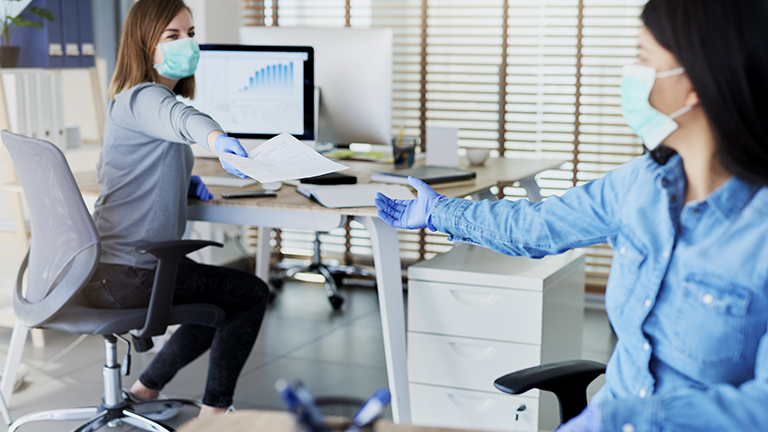
Entry and Receiving Protocols
New protocols to control and monitor access to the building can also help owners protect occupants. Restricting building access to only tenants and essential visitors can reduce the potential for occupants to be exposed to the virus. Staff can reduce the number of building entrances to more easily direct entrants to monitored routes that receive additional cleaning. Staff should reconfigure visitor-registration procedures so that visitors do not need to lean over reception areas. One alternative is to facilitate visitor registration by mobile phone. Staff can also provide visitors with PPE such as face masks to reduce the chance that they spread the virus.
For buildings with several floors, owners should consider protocols for managing access to elevators. In addition to signage and floor markers indicating safe spacing for elevator queues and within elevators, owners should consider devoting staff to monitor elevator lobbies to manage flow and ensure that elevator occupancy does not exceed passenger limits. As an example of the potential implications of social distancing in tall buildings, global marketing company Interpublic Group determined that if only two or three of their staff at one location could ride an elevator at one time, it would take two to three hours for all of them to reach their offices.4 In larger office buildings, owners may need to coordinate staggered employee arrival and departure times with tenants to avoid overwhelming elevator capacity and creating crowded conditions near elevator lobbies. If a building has multiple elevators, it may make sense to dedicate one or more elevators to descending traffic.
Owners can also encourage occupants to use the stairs by designating individual stairwells for one-way traffic when they are not needed in an emergency. Staff can also change the direction of one-way traffic within stairwells in the mornings and afternoons to accommodate peak usage, but this should be accompanied by updated signage, and traffic directions should be communicated to tenants in advance.
Another way to improve occupant safety is to develop a centralized system for handling mail and packages so that carriers do not need to enter tenant offices. Where possible, designate an area for shipping and receiving that is separate from visitor registration. Building staff who handle mail and packages should wear PPE and sanitize the exteriors of packages before delivering them to tenants.
Screening for Coronavirus Symptoms
Owners may also consider screening tenants and visitors for fevers, but they should be aware that they could potentially expose themselves to additional legal liability by doing so. Federal, state and local guidelines on screening for coronavirus symptoms focus on employers, not landlords. Screening tenants and visitors could create a legal “duty to care” that would not exist without the screening. Owners could expose themselves to added liability should they fail to deny an infected individual entry to a building.6 A safer approach would be to restrict the general public and non-essential visitors from entering the building, and encourage tenants to conduct their own screenings. |
Federal Guidelines for a Phased Return to Work
Regulations for the reopening of businesses will primarily be determined by state and local governments. Building owners should refer to the latest state and local regulations that apply to their buildings and tenants. However, at the time of this brief’s release, state regulations remain in flux, with different states allowing different levels of economic activity to resume and some remaining under stay-at-home orders.
Most state governments have indicated they are pursuing a strategy informed by White House and CDC criteria for a phased re-opening of the economy. The suggestions that the White House and CDC have identified for each phase can help owners predict what to expect from state and local officials as they evaluate whether to begin reopening their states or proceed to the next phase. Here is a brief summary of the recommendations that are likely to affect office buildings:7
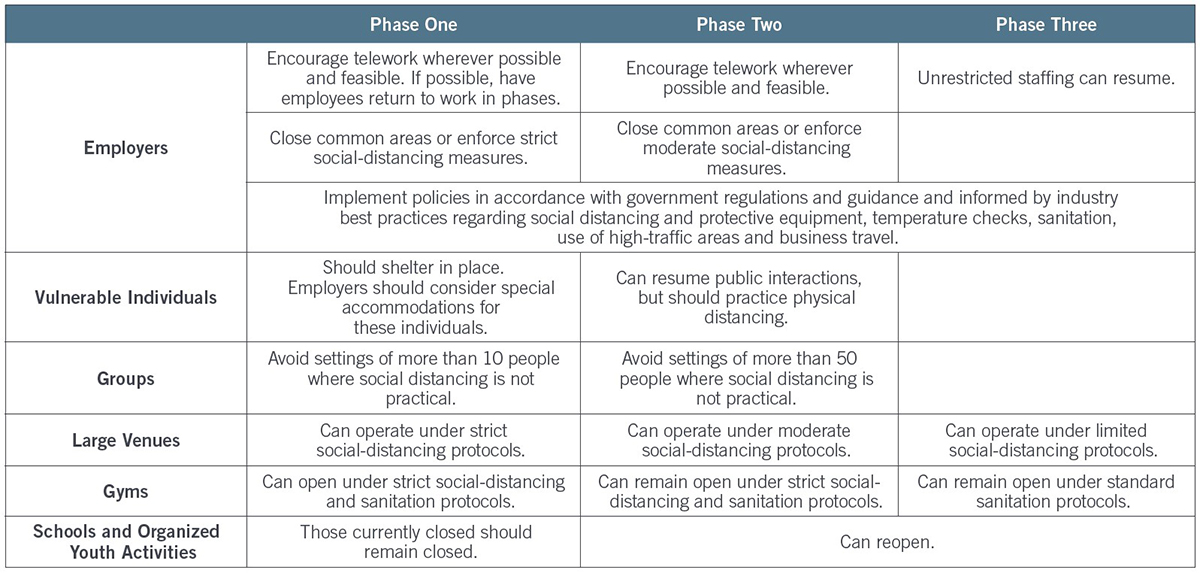
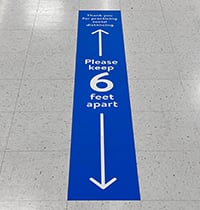
Implications for Building OwnersBuilding owners will need to implement and maintain effective protocols for social distancing and sanitation throughout all three phases. While workers who had remained at home will begin to return in the first phase of reopening, more are likely to return in the second phase, when schools and childcare facilities are allowed to reopen. A significant portion of employees in businesses that can support telework, as well as the elderly and those with chronic illnesses, are likely to remain at home or return to shared worksites infrequently until the third phase. Although guidelines for groups, large venues and gyms suggest that re-opening common areas and amenities may be possible during the first two phases, building owners may prefer to keep shared amenities such as conference rooms and gyms closed unless it is feasible for staff to frequently clean these spaces and monitor them to ensure that occupants are following proper physical-distancing protocols. |
Best Practices for Employers
Most of this brief addresses building operations from an owner’s perspective, but it is helpful to provide tenants with basic recommendations to protect their employees’ health and safety. This information is also helpful for real estate firms as their own staff adapt to new work environments during the outbreak. Many of the measures identified earlier to encourage physical distancing and hygiene, such as signs to promote proper handwashing, the designation of one-way traffic flows and the provision of hand sanitizer and disinfectant supplies, are as important within an office as they are throughout a building. However, employers should consider additional measures to prepare the interiors of their offices and to get their employees ready for a safe return to work. For additional information on protecting employees from coronavirus infection, employers should consult OSHA’s website on COVID-19.

Communication is Key
It will be important for employers to focus on clear communication with employees to adjust to new work arrangements. Fears about the virus are likely to be a significant and ongoing concern for employees during the outbreak. Encourage employees to express their concerns so that they can be effectively addressed. Solicit input through emails, surveys and virtual suggestion boxes. Once an employer develops new protocols for returning to the workplace, communicate these clearly and regularly to employees through emails, virtual meetings and virtual training.
Reconfiguring Work Arrangements
To comply with state and local regulations and achieve recommended physical distances between employees, most employers will need to take a gradual approach to returning to the office. Employers should consider returning their employees to the office in phases until the outbreak is no longer a major threat to public health.
Any plan for returning to the office should comply with state and local regulations. Vulnerable employees, such as the elderly and those with chronic health conditions, should continue to telework until local authorities indicate it is safe for them to return to the office. Employees with minor children may also seek to work from home until schools and daycare centers reopen.
Safe distancing within densely configured offices will also require that other employees work from home some or all of the time. To allow more employees to access the office while maintaining safe spacing, employers can place non-vulnerable employees on a rotational schedule so that they alternate between days in the office and days at home. Tenants in tall buildings should also consider adjusting employee work schedules so that they arrive and depart at different times to avoid overwhelming building elevators. Employers should also consider screening employees for coronavirus symptoms, a practice recommended by the CDC.8
This could take the form of temperature checks and/or symptom questionnaires that can be administered virtually on a daily basis. As noted earlier, the Equal Employment Opportunity Commission has permitted employers to screen employees for coronavirus symptoms. In some states and municipalities, employer health screenings may be encouraged or mandatory.
If an employee tests positive or is suspected to have contracted the coronavirus and has recently been in the office, their employer should close the area in which they worked. The CDC advises that this area remain vacant for 24 hours before a thorough cleaning.9 Employers should also notify the building owner, and they should notify other employees who work in the area that they may have been exposed to the virus, while maintaining the confidentiality of the sick individual.
To limit the potential impact of an ill employee, employers with larger offices can divide them into “neighborhoods” of up to 30 coworkers who do not have contact with other employees. These neighborhood areas can then be closed and cleaned in the event of an infection without having to shut down an entire office.10 To improve occupant safety, train employees in safe distancing and handwashing protocols, and provide them with hand sanitizer and tissues. The CDC also recommends that employers conduct a hazard assessment to identify additional protocols to protect employees, such as providing them with PPE. If medical respirators are not required, encourage employees to wear a cloth face mask.11 Regular hand-washing breaks should also be encouraged. Provide individual employees with their own waste baskets and ensure that any communal waste baskets can be used without manually touching them.
Reconfiguring Space
Most employers will need to reconfigure office interiors to adhere to physical-distancing measures. In offices where employees do not already sit six feet apart, employers will need to increase the space between them. This can be accomplished by a combination of measures — assigned seating, employees alternating workdays in the office, moving desks farther away from each other, and removing chairs from desks or shared workstations. For improved safety, workers should face away from each other or have a barrier between them. Consider installing temporary barriers if they are not already present, or adding height to existing barriers.
Most common areas within offices will also need to be reconfigured. Remove chairs from conference rooms and call rooms to ensure safe spacing. Identify the maximum occupancy that common areas can safely accommodate using six-foot physical spacing and post maximum occupancies at the entry to each area. Alternatively, employers may wish to reconfigure conference rooms and call rooms as temporary desks to accommodate more employees. These rooms may require the installation of temporary barriers to ensure occupant safety. Employers may also consider consulting design and propertymanagement firms for professional guidance when reconfiguring office space. Gensler has developed a tool called ReRun to help employers evaluate how to safely spread out seating arrangements under different occupancy scenarios.12 Cushman & Wakefield has developed a prototype for using carpet tiles, desk dividers and floor signage to safely space office occupants.13
Employers will also need to reconfigure kitchens and break rooms to reduce sources of viral transmission. Remove coffee machines and beer taps. Get rid of disposable plates and utensils as sources of contamination. Replace communal food with individually wrapped snacks. Encourage employees to bring their own food and beverage items to replace those previously provided by an employer. Employers might also consider acquiring additional appliances. McCann Worldgroup has ordered additional microwaves and refrigerators to accommodate employees bringing their own lunches to the office.14 Tenants should also consider installing or repurposing building sensors to improve office safety. Replace manual light switches with simple motion sensors. More advanced sensor systems can monitor occupancy and physical distancing.
Be Ready for a Second Wave
Employers should prepare for the possibility that a second wave of infections could force them to close their office again. To that end, they should have a plan in place for a smooth transition to a remote work environment. Employers can review the steps they took during the initial closure to identify measures that worked well and those that did not. Communicate any plan to employees so that everyone is prepared should they need to return to teleworking.
About NAIOP
NAIOP, the Commercial Real Estate Development Association, is the leading organization for developers, owners and related professionals in office, industrial, retail and mixed-use real estate. NAIOP comprises some 20,000 members in North America. NAIOP advances responsible commercial real estate development and advocates for effective public policy. For more information, visit naiop.org.
The NAIOP Research Foundation was established in 2000 as a 501(c)(3) organization to support the work of individuals and organizations engaged in real estate development, investment and operations. The Foundation’s core purpose is to provide information about how real properties, especially office, industrial and mixed-use properties, impact and benefit communities throughout North America. The initial funding for the Research Foundation was underwritten by NAIOP and its Founding Governors with an endowment established to support future research. For more information, visit naiop.org/researchfoundation.
About the Author
Shawn Moura, Ph.D., is director of research at NAIOP. To submit questions or comments about this research brief, contact moura@naiop.org.
Media Inquiries
Please contact Kathryn Hamilton, vice president for marketing and communications, at hamilton@naiop.org.
Disclaimer
This project is intended to provide information and insights to industry practitioners and does not constitute advice or recommendations. NAIOP disclaims any liability for actions taken as a result of this project and its findings.
© 2020 NAIOP Research Foundation
Endnotes
1“Interim Guidance for Businesses and Employers Responding to Coronavirus Disease 2019 (COVID-19),” Centers for Disease Control and Prevention, May 2020, https://www.cdc.gov/coronavirus/2019-ncov/community/guidance-business-response.html; “CDC Activities and Initiatives Supporting the COVID-19 Response and the President’s Plan for Opening America Up Again,” Centers for Disease Control and Prevention, May 2020, https://www.cdc.gov/coronavirus/2019-ncov/downloads/php/CDC-Activities-Initiatives-for-COVID-19-Response.pdf; “Recovery Readiness: A How-To Guide for Reopening Your Workplace,” Cushman & Wakefield, April 22, 2020, https://www.cushmanwakefield.com/en/insights/covid-19/recovery-readiness-a-how-to-guide-for-reopening-your-workplace; “(re)entry: A Guide for Working in the Next Normal,” JLL, April 2020, https://www.us.jll.com/content/dam/jll-com/documents/pdf/other/reentry-guide-for-working-in-the-next-normal.pdf; Elizabeth Brink and Arnold Levin, “What Happens When We Return to Work?” NAIOP Webinar, April 30, 2020, https://learn.naiop.org/products/what-happens-when-we-return-to-work-webinar.
2 “Guidance for Reopening Buildings After Prolonged Shutdown or Reduced Operation,” Centers for Disease Control and Prevention, May 7, 2020, https://www.cdc.gov/coronavirus/2019-ncov/php/building-water-system.html.
3 “Getting Back to Work: Preparing Buildings for Re-Entry Amid COVID-19,” May 1, 2020, https://www.boma.org/coronavirus.
4 Chip Cutter and Suzanne Vranica, “Reopening the Coronavirus-Era Office: One-Person Elevators, No Cafeterias,” The Wall Street Journal, May 11, 2020, https://www.wsj.com/articles/reopening-the-coronavirus-era-office-one-person-elevators-no-cafeterias-11589189402?mod=hp_lead_pos5.
5 Patrick DePoy, “U.S. COVID-19: Employee Temperature Screening: What Employers Need to Consider When Deciding Whether to Implement a Screening Process,” Bryan Cave Leighton Paisner, April 14, 2020,
https://bclpatwork.com/us-covid-19-employee-temperature-screening-what-employers-need-to-consider-when-deciding-whether-to-implement-a-screening-process/.
6 Eric Greenberg, Brent Clark and Gabriel Goldenberg, “Commercial Landlord Guidance: Should You Take the Temperature of Your Tenants?” Seyfarth, March 31, 2020, https://www.seyfarth.com/news-insights/commercial-landlord-guidance-should-you-take-the-temperature-of-your-tenants.html.
7 “Opening up America Again,” The White House, https://www.whitehouse.gov/openingamerica/#criteria.
8 “Interim Guidance for Businesses,” 2020.
9 Ibid.
10 Katie Canales, “Experts say the office as we knew it is gone and companies will need one-way hallways, sneeze guards, and other safety measures to let employees return. Here’s what it could look like.” Business Insider, May 6, 2020, https://www.businessinsider.com/going-back-to-work-office-design-coronavirus-2020-5.
11 “Interim Guidance for Businesses,” 2020.
12 Cindy Coleman, Don Ricker and Jane Stull, “10 Considerations for Transitioning Back to Work in a Post-COVID-19 World,” Gensler Research & Insight, April 20, 2020, https://www.gensler.com/research-insight/blog/10-considerations-for-transitioning-back-to-work-in-a-post.
13 Jena McGregor, “The Post-Pandemic Workplace Will Hardly Look Like the One We Left Behind,” The Washington Post, April 23, 2020, https://www.washingtonpost.com/business/2020/04/23/offices-after-coronavirus/; “6 Feet Office,” Cushman & Wakefield, https://www.cushmanwakefield.com/en/netherlands/six-feet-office.
14 Cutter and Vranica, 2020.

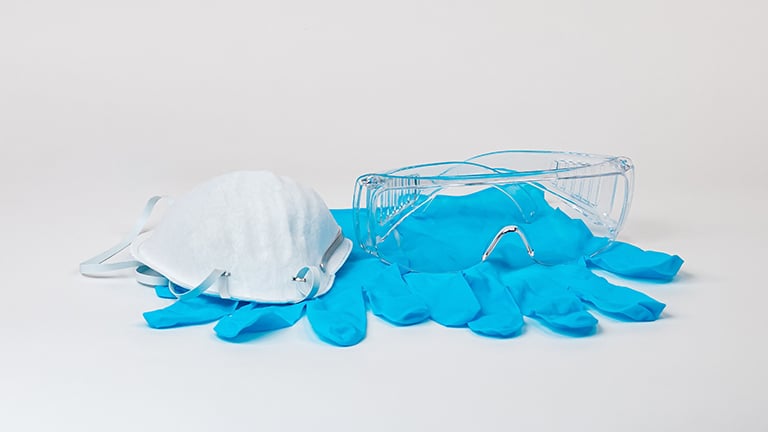 Building owners should consider screening their own staff for fevers and asking employees to monitor their health for other symptoms of the coronavirus. Temperature checks would normally be considered a medical exam and restricted by the Americans with Disabilities Act, but the Equal Employment Opportunity Commission has updated its guidance to employers, permitting them to screen employees for fevers due to the coronavirus outbreak. In some jurisdictions like Ohio and Delaware, employers are either encouraged or required to screen employees for fevers and other symptoms.5
Building owners should consider screening their own staff for fevers and asking employees to monitor their health for other symptoms of the coronavirus. Temperature checks would normally be considered a medical exam and restricted by the Americans with Disabilities Act, but the Equal Employment Opportunity Commission has updated its guidance to employers, permitting them to screen employees for fevers due to the coronavirus outbreak. In some jurisdictions like Ohio and Delaware, employers are either encouraged or required to screen employees for fevers and other symptoms.5